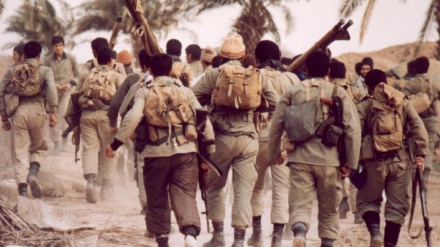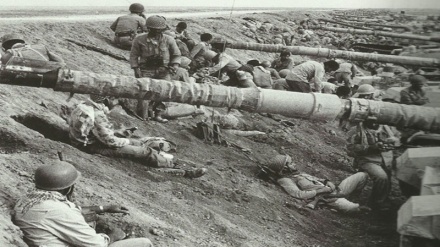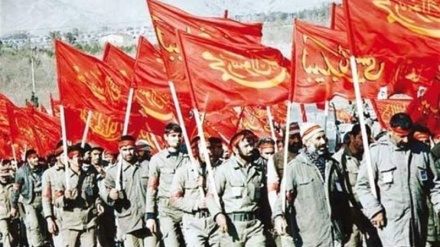Glimpses of Epic of 8-Year Holy Defense (6)
The city of Khorramshahr has been one of the famous port cities of Iran. One of Saddam's primary goals in invading and occupying Khuzestan province was the occupation and capture of Khorramshahr and Abadan.
Iran's largest refinery was located in Abadan, and the cities of Khorramshahr and Abadan had a strategic economic and geopolitical significance with little distance from each other.
The Iraqi forces' assault on Khorramshahr port faced with a very strong barrier constituted of Basiji (popular forces), the Islamic Revolution Guards Corps and the Army. Defenders of Khorramshahr resisted almost with empty hands and few military equipment against the fully equipped and armored troops of the Ba'athist regime in Iraq. The enemy thought that with the arrival of Saddam's army at the gates of Khorramshahr, the resistance of the city's defenders would break down and the city would collapse.
One of the Iraqi commanders in this case says: We were convinced that the city had fallen into the hands of the Iraqi forces, while the opposite of this happened. The defenders of Khorramshahr allowed our forces to enter the city, and then surrounded them, and with whatever weapons they had, they destroyed more than two-thirds of the tanks of Al-Hasan battalion and more than half of the vehicles of mechanized battalion, killing a number of them and taking some of them as captives.
The Iraqi commander described the situation of the assailant forces as follows: "I saw with my eyes at 16:15 on October 2, 1980, that the Iraqi forces advanced by tanks and vehicles through the main route of the city while they were very sad and shaky and uncontrollable. They were defeated and retreating. They had sustained heavy casualties and losses. The Al-Hassan battalion had lost more than 23 tanks; 17 Scott vehicles manufactured in Czechoslovakia belonging to the mechanized battalion were destroyed, and dozens were killed or captured and others were defeated.”
October 2, 1980 is considered an important day for the defenders of Khorramshahr in spite of difficulties. On this day around Khorramshahr railway square, defenders of the city struck the enemy tanks like thunder and destroyed the tanks of the Iraqi army one after the other by just throwing grenades and Molotov cocktails. The enemy, with the reinforcement of his forces, had planned to occupy the city. However, despite the occupation of the gateway to railway square, the enemy suffered another defeat and retreated. Homayoun Soltanifar, one of the brave defenders and epic-makers of Khorramshahr said: "October 10 was a bloody day for Khorramshahr. That day, the Iraqis came from the slaughterhouse to the city and when they took the railway, the brave combatants created one of the great epics of the holy defense in the Khorramshahr railway gates. "
The intensity and speed of the actions of the Muslim combatants made the Iraqi commanders lose control over their forces. Some of the enemy elements had escaped the battlefield. Although the courage of the youths and teenagers, both men and women, in all years of resistance is admirable, October 2nd demonstrated unique valour and epic of empty hands but hearts which were filled with faith and trust in God. On this day, a terrible defeat was inflicted on the enemy and selfless combatants showed to the enemy that they would defend their city and religion with the least equipment. The heavy fiasco of the Ba'athist army for breaking the resistance of the brave youths of Khorramshahr and occupying the city forced the Iraqi commanders to change their military array. After the deployment of Iraqi forces in new positions, the main effort of the enemy was focused on advancing into the city in any possible way.
Based on a new planning, in the dawn of October 5, 1980, the Ba'athist army launched a massive invasion, and after much effort, it succeeded to advance only 50 meters into Khorramshahr port, but this time it also sustained a lot of damage and casualties. Thus, the commander of the Iraqi Army's Third Division, Ismail al-Naimi, visited the main headquarters of the 33rd brigade in order to probe into the Iraqi units. Abdul Rahman Abdul Wahed, major general of the Iraqi army, also entered the area as the unit's advisor to draw the outline of the situation and report it to the main headquarters of Khorramshahr occupation operation.
The enemy's strategy after these defeats was a constant change in the arrangement of military units and heavy artillery fire in support of armored units and infantry. As a result of this heavy artillery fire, there was no spot in the city of Khorramshahr that was not burned in fire. Smoke swept the whole city. Many civilians and combatants were brutally martyred or wounded. One of the beauties of the city of Khorramshahr, before the outbreak of the war, was the palm trees of the city. Many of these palm trees were burned in fire and the farmlands had turned into burnt soil or graveyard of tanks and shrapnel and useless weapons.
The enemy infiltrated into the city from October 6 - 8 after strengthening its forces, but the Khorramshahr Jame' Mosque as a base of resistance and mobilization of popular forces was still at the disposal of the Muslim combatants. Khorramshahr Bridge was also in the control of the brave defenders as the connector of the western and eastern parts of the city to provide support for forces.
The advancement of the Ba'athist army continued despite sustaining heavy losses, and the city defenders continued to resist despite receiving no support from outside the city. Because of the major failure of its forces in other areas of the offensive on the southern front, Saddam needed an eye-popping victory to justify invasion of Iran. He had promised to occupy Khuzestan province at most in three days, but he faced with a very stiff resistance of combatant people to defend their homeland and revolution.
The Iraqi dictator was kept behind the gates of Khuzestan, especially Khorramshahr while he had no way back or forward. That's why the swift occupation of Khorramshahr turned into a matter of repute for Saddam. The Iraqi invading units, by changing their military array and strengthening their forces, tried to tighten the noose around the defenders of Khorramshahr.
In the next program, we will tell you more about the resistance of Iranian youths against the aggression of the Iraqi Ba'athist army.
RM/SS


